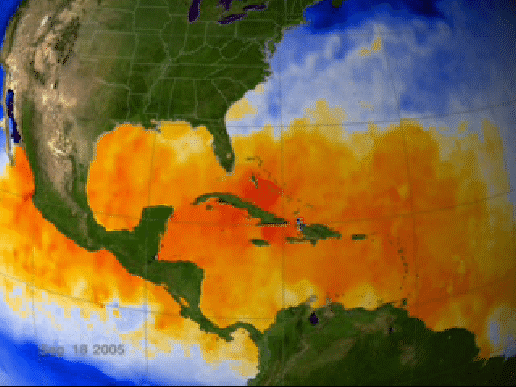So you want to cook up a hurricane in the Atlantic—reach into your cupboard and take out:
1. A ripe thunderstorm drifting into the Atlantic,
2. Hot waters,
And
3. Some favorable winds.
I won’t question your motives. Maybe you are crazy. Maybe you’re a Texan who is willing to put up with some wind if you could just finally get some rain. You want a hurricane, so here are the three things you need:
A ripe thunderstorm – First you need a storm. At this time of year, your best supplier is Africa. After decades of a growing Sahara desert, Africa is starting to get more rainfall. This is great for farmers living south of the Sahara but dangerous for the ships at sea. These storms drift into the Atlantic Ocean, waiting for a chance to grow.
Of course you can get homegrown storms. Sometimes a thunderstorm drifts off a US, Mexican or Central American coast and lands in the Caribbean or the Gulf of Mexico. They find themselves swimming in …

September is when the Atlantic waters are ideal for hurricanes. SOURCE: NASA
Hot waters – For an ambitious little thunderstorm to grow into a mighty tropical storm, you need tropically hot water. The area needs to have at least 150 feet of 80˚F water. This water is the fuel for the storm. This time of year, ocean temperatures peak and the Atlantic has a lot of hot water.
The water heats the air above it. The warm air rises and more air moves in to replace it. That warm air also rises and is replaced. When the warm moist air finally reaches the colder air overhead, it cools off and rains out. The storm grows stronger and bigger. It would just be a big storm unless there are …
Favorable winds – Hurricanes are huge, so it is difficult to get the winds to be blowing in the right direction at all levels. Most of the time the higher winds sheer the tops.
.gif)
SOURCE: http://eo.ucar.edu/webweather/hurricane2.html
There is a maverick weather pattern, the pulse of the Madden Julian Oscillation (MJO), which has almost perfect winds for growing hurricanes. (See my last week’s blog) It travels eastward around the equator and lingers in any one place for 4 to 8 weeks. Scientists watch it on satellites. Unfortunately it arrived over the Atlantic a couple of weeks ago. It will be a few weeks before it drifts away.
There are your three ingredients to grow a magnificent hurricane. Bon appétit!
Comments